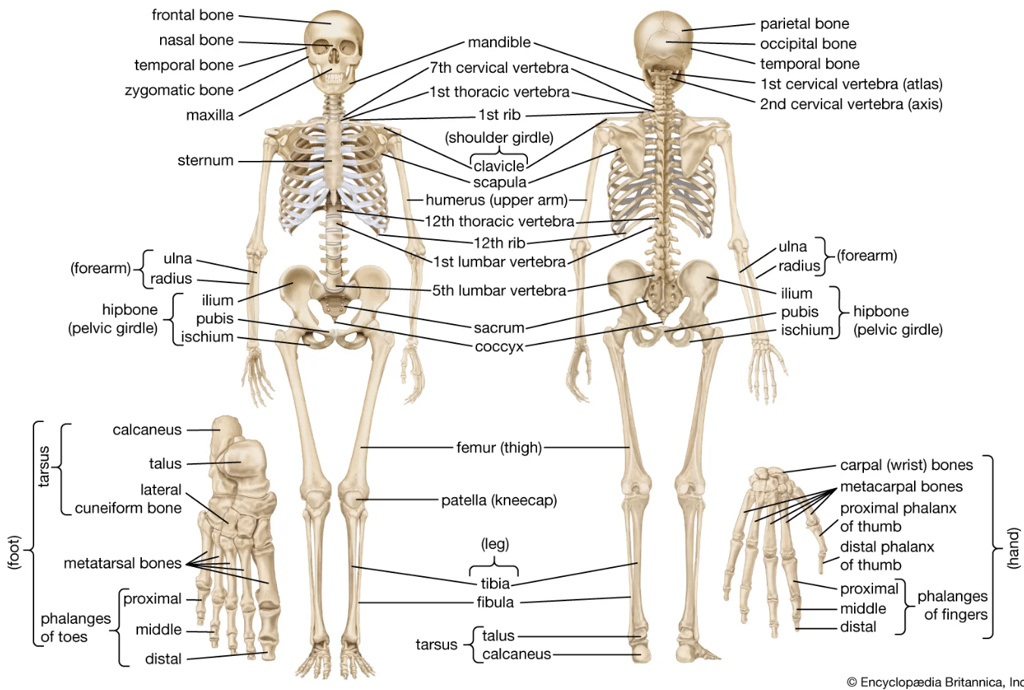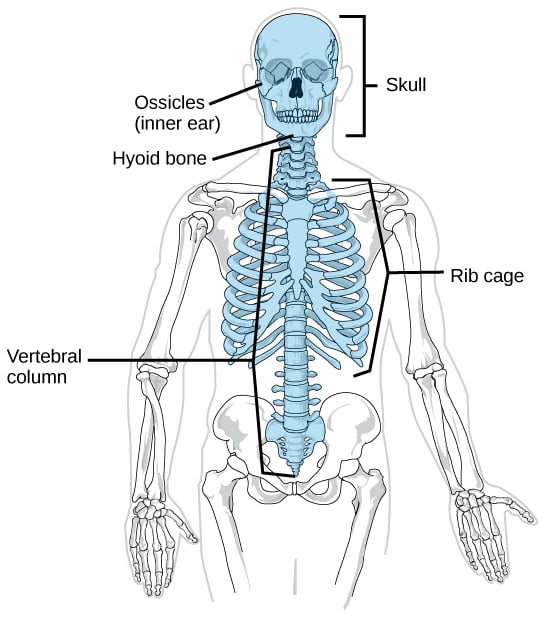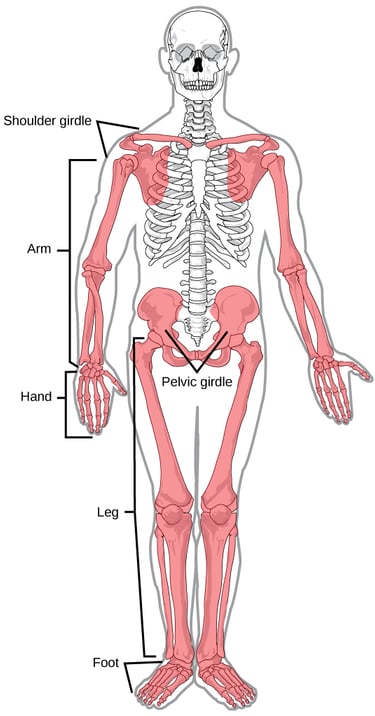Skeletal System
Altogether, the skeleton makes up about 20 percent of a person's body weight. The human adult body consists of 206 bones, which are arranged into two parts called the axial and appendicular skeletons. This article provides you with a basic overview of the human skeletal system and its functions.
MUSCULOSKELETAL SYSTEM
7/9/20245 min read


The human skeletal system includes all of the bones, cartilage, ligaments, and tendons of the body. Altogether, the skeleton makes up about 20 percent of a person’s body weight. The primary functions of the skeleton are to provide a rigid framework that can support the weight of the body against the force of gravity and to provide a structure upon which muscles can act to produce bodily movements. The lower portion of the skeleton is designed for stability during walking or running, and the upper skeleton has greater mobility and ranges of motion, which are features that allow for lifting and carrying objects or turning the head and trunk. The skeleton also has protective and storage functions. Its protective function is to protect the internal organs (i.e., the brain, spinal cord, heart, lungs, and pelvic organs). And the bones themselves serve as the primary storage site for important minerals such as calcium and phosphate. Additionally, bone marrow, which is found within bones, stores fat and the blood cell producing tissue of the body.
The human adult body consists of 206 individual bones that are arranged into two divisions called the axial and appendicular skeletons.
The axial skeleton is made up of 80 bones and forms the central axis of the body as shown in Figure 2. The axial skeleton includes the bones of the skull, inner ear, neck, vertebral column, and ribcage. The axial skeleton supports and protects the brain, spinal cord, and organs in the ventral cavity (i.e., the interior space in the front of the body). It provides a surface for the attachment of muscles that move the head, neck, and trunk, performs respiratory movements, and stabilizes parts of the appendicular skeleton.
Skull. The skull consists of 22 bones divided into two categories: cranial and facial bones. The 8 cranial bones form the cavity, which encloses the brain and serves as an attachment site for the muscles of the head and neck. The 14 facial bones form the face, provide cavities for the sense organs (eyes, mouth, and nose), protect the entrances to the digestive and respiratory tracts, and serve as attachment points for facial muscles.
Auditory ossicles. The auditory ossicles are a collection of 6 small bones (in fact, the smallest bones in the body) found within the inner ear that transmit sound from the eardrum to the inner ear.
Sources
[1] Andrew, W. (2024, January 31). human skeleton. Encyclopedia Britannica. https://www.britannica.com/science/human-skeleton
[2] Cleveland Clinic. (2022, February 8). Axial skeleton: What bones it makes up. Cleveland Clinic. https://my.clevelandclinic.org/health/body/22344-axial-skeleton#anatomy
[3] Lumen Learning. (n.d.). The Musculoskeletal System. Biology for Majors II. Module 23. https://courses.lumenlearning.com/wm-biology2/chapter/human-appendicular-skeleton/
[4] Lumen Learning. (n.d.). The Musculoskeletal System. Biology for Majors II. Module 23. https://courses.lumenlearning.com/wm-biology2/chapter/human-axial-skeleton/
[5] Lumen Learning. (n.d.). The Skeletal System. BIO103 Human Biology. Chapter 7. https://courses.lumenlearning.com/suny-dutchess-ap1/chapter/human-skeletal-system/
[6] Seladi-Schulman, J. (2018, August 30). Skeletal system: Anatomy and function, diagram, diseases, and more. Healthline. https://www.healthline.com/human-body-maps/skeletal-system
[7] Taylor, T. (2020, July 29). Interactive guide to the skeletal system. Innerbody. https://www.innerbody.com/image/skelfov.html
Hyoid. The only bone that does not form a joint with another bone, the hyoid bone is a U-shaped bone found at the base of the jaw and in front of the neck. It acts as a movable base for the tongue and is connected to muscles of the jaw, larynx, and tongue, helping with breathing, speaking, and swallowing.
Vertebral column. The vertebral column, or spinal column, surrounds and protects the spinal cord, supports the head, and acts as an attachment point for the ribs and muscles of the back and neck. The adult vertebral column comprises 26 bones: 24 vertebrae, the sacrum, and the coccyx bones. The 7 bones found in the head and neck are called cervical vertebrae, the 12 bones found in the upper back are called thoracic vertebrae, and the 5 bones found in the lower back are called lumbar vertebrae. The sacrum and coccyx are made up of several fused vertebrae and help support the weight of the body while sitting and serve as ligament attachment points.
Rib cage. The rib cage (or thoracic cage) is made up of the sternum (breastbone) and 12 pairs of ribs, which together enclose and protect the organs of the thoracic cavity, including the heart and lungs. The rib cage also provides support for the shoulder girdles and upper limbs and serves as the attachment point for the diaphragm, muscles of the back, chest, neck, and shoulders.
The appendicular skeleton is made up of 126 bones that consist of the bones of the arms, legs, and bones that attach them to the axial skeleton as shown in Figure 3. The appendicular skeleton is composed of the bones of the upper limbs (which function to grasp and manipulate objects) and the lower limbs (which permit locomotion). It also includes the pectoral girdle, or shoulder girdle, that attaches the upper limbs to the body, and the pelvic girdle that attaches the lower limbs to the body.
Shoulder girdle. The shoulder (or pectoral) girdle is where the upper limbs attach to the axial skeleton. It consists of the clavicle (collarbone) and scapula (shoulder blade), and there are two of each, i.e., one for each arm.
Upper limbs. There are 30 bones in each upper limb, which includes the arm (shoulder to elbow), the forearm (ulna and radius), and the hand.
Pelvic girdle. The pelvic girdle is where the lower limbs attach to the axial skeleton. Because it is responsible for bearing the weight of the body and for locomotion, the pelvic girdle is securely attached to the axial skeleton by strong ligaments. It also has deep sockets with robust ligaments to securely attach the femur to the body and is further strengthened by two large hip bones.
Lower limbs. There are 30 bones in each lower limb, which consists of the thigh, the leg, and the foot. The bones of the lower limbs are thicker and stronger than the bones of the upper limbs because of the need to support the entire weight of the body and the resulting forces from locomotion.




Figure 1. Diagram of human skeleton with bones labeled [1].
Figure 2. The axial skeleton supports the head, neck, back, and chest forming the vertical axis of the body [4].
Figure 3. The appendicular skeleton consists of the pectoral and pelvic girdles and all the bones of the upper and lower limbs [3].
Copyright © 2024-2025 AnlianFitness. All rights reserved.
Follow us on social media.
